In the last two decades, U.S. Supreme Court has become rapidly more polarized, making landmark decisions that have changed the landscape of American life. Most notably, the court voted to overrule Roe v. Wade in June, removing federal protections for abortion rights.
The decision highlights how that polarization emerged.
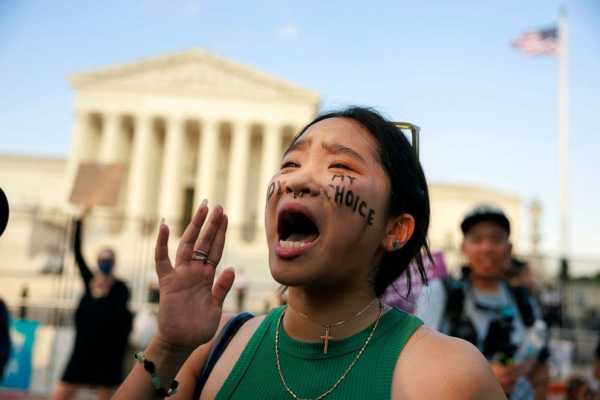
Robin Gwak protests outside the Supreme Court of the United States after a conservative majority struck down Roe v Wade in Washington, June 25, 2022.Jeremy Hogan/Sopa Images/Sipa USA via AP, FILE
How Roe v. Wade changed the Supreme Court
The current court uniquely has six conservative justices, all nominated by Republican presidents, and three liberal justices, all nominated by Democratic presidents. This year, the court voted along ideological lines in 21% of cases.
"This is a court where the justices and their votes seem to track politics in a way we just haven't seen before in American history," said Kate Shaw, a Supreme Court expert and ABC News contributor.
In some states, women immediately lost access to abortion as soon as Roe was overruled.
But polling shows that only 25% of Americans have full trust in the court. A striking 62% of Americans believe women should have access to abortion.

An examination room of a Planned Parenthood Health Center is seen on July 9, 2022 in Louisville, Kentucky.Jon Cherry/Getty Images
Once considered the weakest branch of the federal government, the Supreme Court's powers are not explicitly written into the Constitution. That changed when a landmark decision in 1803, Marbury v. Madison, gave the court sole authority to decide the meaning of the Constitution and interpret laws passed by Congress.
"The Supreme Court, over the course of American history, has dramatically expanded the scope of freedom, the protection of equality," said Erwin Chemerinsky, dean of the University of California Berkeley School of Law.
But, the court draws its power from the American people's acceptance of its power, according to another expert.
"As an institution, it has built up regard over the centuries and has built up the power to command authority and to get the political branches to follow its decisions. But in a large respect, that power depends on its acceptance by the American people. If the American people don't accept the judgments of the Supreme Court, it will lose the power that it has," said Bernadette Meyler, a professor at Stanford Law School.
Even though the court is designed to be apolitical, the process of appointing a justice is very political. Justices are nominated by the president and confirmed by the Senate, all politicians who are very aware how important their vote is to voters.
"I think that the story of how we got this current Supreme Court is very interesting. It really begins in a way with the decision of Roe and the backlash against that decision in favor of women's right to choose an abortion," Meyler said.
After Roe was issued in 1973, conservatives spent decades working to transform the judicial branch.
"In the aftermath of that decision, a lot of conservative thinkers were trying to figure out what kind of constitutional strategy would work to overturn the decision of Roe and other rights-protective decisions that had emerged from the Warren Court and afterwards," Meyler said.
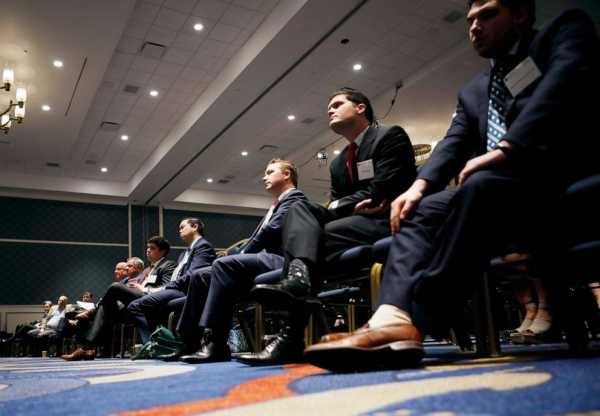
Federalist Society members attend the Federalist Society Sixth Annual Florida Chapters Conference in Lake Buena Vista, Florida, Jan. 31, 2020.Octavio Jones/Tampa Bay Times via AP
Rise of the Federalist Society
Supreme Court Chief Justice Earl Warren, a liberal icon, presided over landmark court decisions expanding civil rights, including Brown v. Board of education, which desegregated schools; Loving v. Virginia, which provided protections for interracial marriage; Griswold v. Connecticut, which granted access to contraception; and Miranda v. Arizona, which ensured that people know their rights before being interrogated.
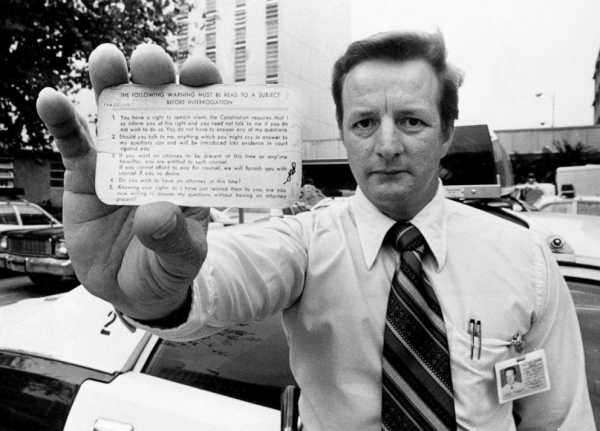
Commander Ralph Page demonstrates a Miranda card, as law enforcement officers throughout the country must do on making an arrest, Nov. 16, 1976.Robert Houston/AP, FILE
Met with the disapproval, Warren's liberalism was responded to with a strong reaction from conservatives who developed the Federalist Society, a movement of conservative legal scholars founded in 1982.
"You have a number of really important and society changing opinions that come from the Supreme Court in those years. And the Federalist Society is really a response to that and a desire to really change the understanding of the Constitution in response to many of those decisions," Shaw said.
Their legal theory, originalism, centers on the idea that the Constitution should be understood as it was meant at the time it was originally written.
"Our approach does not view the Constitution as some kind of super municipal code designed to address issues of a particular era," said Edwin Meese, former U.S. attorney general and an originalist.
Originalism, surprisingly, became a powerful social movement, according to Meyler.
Arguably, no group has had as much influence over federal courts in the last 40 years as originalists. The group has exerted influence on the selection and confirmation of judges across the judiciary.
"I believe that originalism was developed as an approach to constitutional protection, as a way of opposing Warren court decisions," Chemerinsky said.
Critics say Democrats left the originalist movement largely unanswered, failing to come up with a counterweight.
"I think that conservatives have done a much better job of organizing around the Supreme Court and a much better job of looking to fill vacancies on the federal courts with those who are very conservative," Chemerinsky said.
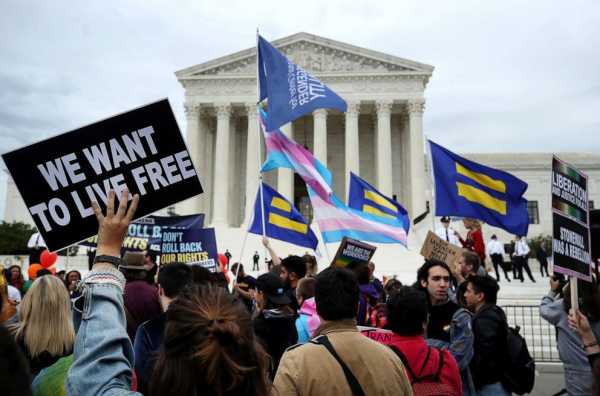
Protesters rally in front of the U.S. Supreme Court as arguments are heard in a set of cases concerning the rights of LGBT people in the workforce, on October 8, 2019 in Washington, DC.Mark Wilson/Getty Images
Future of a polarized Supreme Court
Conservatives now have a 6-3 supermajority in the court, in large part due to this strategy.
During former President Barack Obama's second term, Senate Republicans refused to hold nomination hearings for Merrick Garland to replace late Justice Antonin Scalia, despite Obama having almost a year left in office.
Obama's successor, President Donald Trump, was able to nominate a rare three justices to the court.
Trump nominated conservative Neil Gorsuch to fill Scalia's seat. Two years later, he was able to nominate conservative Brett Kavanaugh.
Weeks before the 2020 election, the sudden death of Justice Ruth Bader Ginsburg allowed Trump to nominate Amy Coney Barrett, who was rushed through the confirmation process by Senate Republicans.
"I think that McConnell's blockade of Obama's nomination of Merrick Garland was a strong signal that Republican control of the Senate is going to mean Democratic presidents cannot get any Supreme Court justice confirmed, not just in the last year of a presidency, but very likely for the entirety of a presidency," Shaw said.
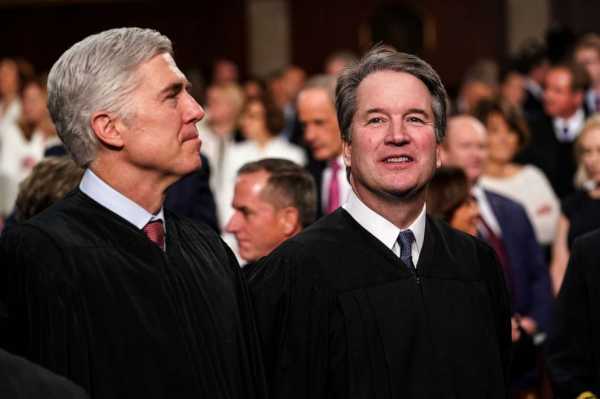
Supreme Court Justices Neil Gorsuch and Brett Kavanaugh attend the State of the Union address in the chamber of the U.S. House of Representatives at the U.S. Capitol Building on February 5, 2019 in Washington, DC.Doug Mills/Getty Images
Polarization is likely to continue affecting the court.
"I expect in our toxic, politically polarized times, if the president and the majority, the Senate, are different political parties, the Senate simply won't confirm presidential nominees for the Supreme Court," Chemerinsky said.
Eight of the nine justices currently on the court were confirmed since 2005, with the oldest justice, Clarence Thomas, now 74 years old.
This means the court's balance of power is unlikely to change soon, prompting progressives to call for an overhaul, expanding the membership of the court and imposing term limits.
"There's no magic number of nine for the Supreme Court justices. It didn't start out as nine. The framers actually didn't imagine that there would be an uneven number of justices," Meyler said.
Congress could, by statute, increase or decrease the number of justices on the court, according to Chemerinsky.
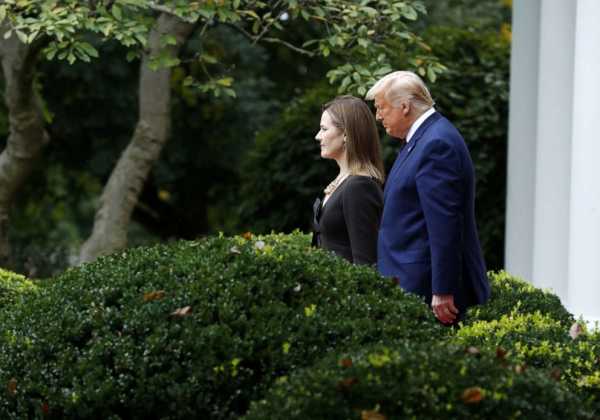
President Donald Trump arrives with Amy Coney Barrett, nominee for associate justice of the U.S. Supreme Court, during an announcement ceremony at the White House in Washington, D.C., Sept. 26, 2020.Shawn Thew/EPA/Bloomberg via Getty Images
But that is unlikely with Republicans, justices themselves and even President Joe Biden all opposed to the idea.
"All of this depends on the idea that there would be a majority in Congress that would be in favor of such limitations. But if there is sufficient popular discontent with the Supreme Court, that should be possible," Meyler said.
Even if Congress does not change the size of the court, a threat of doing so could have some impact on the court's willingness to continue issuing bold and sometimes unpopular decisions, Shaw said.
Still, decisions issued by the court last June could be a sign of what is yet to come.
"One need only think about what are the dominant issues that conservatives care about in this country," said Chemerinsky.
"At the end of October 2022, the court will hear about whether or not it should overrule precedents that allowed college or university engage in affirmative action," Chemerinsky said.
Per the logic of the Dobbs v. Jackson Women's Health Organization decision, which overturned Roe, Meyler said contraception and same sex marriage could also be overturned.
"The pace and the kind of boldness of this new conservative supermajority in just this last term lead me to believe that there is a lot more change in store," Shaw said.
Sourse: abcnews.go.com






